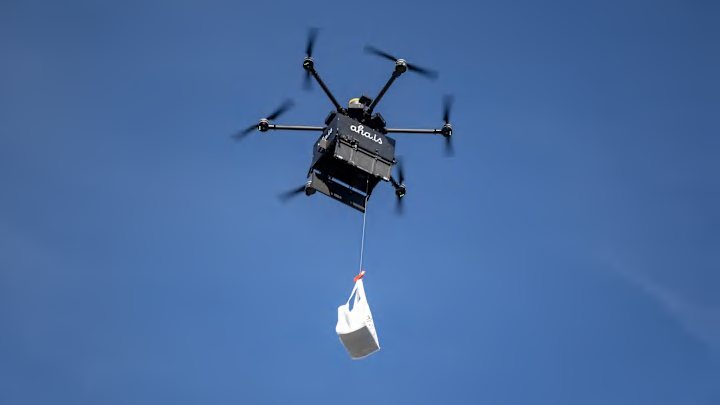Drone food delivery is making waves in the food service industry, promising faster, more efficient delivery with a futuristic touch. While having your meal flown directly to your doorstep may sound exciting, it raises important questions about safety and reliability. Is drone food delivery safe and worth it for consumers who value convenience and food quality?
Learn about the rise of drone food delivery and its safety concerns, and explore whether it’s worth adopting this innovative approach.
The Rise of Drone Food Delivery
Drone food delivery is becoming more than a futuristic concept. Food delivery and prepared meals like Hello Fresh have been popular for the past few years. In 2025, you might track your dinner as it zooms across the sky, delivered by a sleek, buzzing drone.
Drone food delivery could be faster, more efficient and potentially more environmentally friendly than traditional delivery methods. With advancements in drone technology, food delivery services are exploring new ways to bypass traffic, avoid delivery delays and offer consumers a quick dining experience.
An expert on drone technology’s commercial applications, James McDanolds is a program chair in the School of Uncrewed Technology at the Sonoran Desert Institute and has studied drones for 15 years, gaining key insights into the benefits and challenges of integrating drones into the food and beverage industry. Some companies are already experimenting with drone-powered services, bringing convenience to a new level. However, is it as smooth as it sounds, or is there more to the story?
Is Drone Food Delivery Safe?
With any new technology, there are potential risks, and drones are no exception. From the potential for malfunctions mid-flight to privacy issues, it’s essential to consider the safety factors involved in drone food delivery.
Drones operate in complex airspace. A top priority is ensuring that drones don’t interfere with any aircraft or get lost in the sky. Regulations are in place to minimize these risks, but with the rapid growth of drone usage, enforcement and regulation are still catching up.
Malfunctions are another concern. Drones can experience technical failures — such as battery issues or signal loss — which could cause delivery delays or even drone crashes. To prevent this, many companies are investing in robust drone maintenance and real-time monitoring to spot potential issues before they arise. As with any food-handling service’s safety processes — like regularly servicing a dumbwaiter or wearing gloves when preparing food — maintenance must be well-monitored and maintained.
Another aspect to consider is privacy. Drones are equipped with cameras and sensors, which could potentially collect data from people’s homes or private properties. While many drone delivery companies are committed to data protection and complying with privacy laws, it’s an area that still requires vigilance.
In light of these challenges, many drone companies are implementing advanced technologies — like GPS navigation and obstacle detection systems — to enhance safety. Additionally, drones are being designed with redundant systems to ensure they can continue functioning even if one part fails. While safety protocols around drone food delivery are still evolving, companies are taking great strides to make this service as safe as possible.
Best Practices for Drone Food Delivery
These measures help mitigate risks, protect privacy and ensure the overall success of the delivery experience.
For Companies:
- Regulatory compliance: Companies must adhere to local and international airspace regulations. This includes registering drones, obtaining necessary permits and ensuring flights remain within designated areas. By following these rules, businesses can reduce the likelihood of accidents and ensure drones don’t interfere with other air traffic.
- Drone maintenance: Regular maintenance and real-time monitoring of drones are essential. Companies should frequently check the drones’ hardware and software to avoid malfunctions. Many use systems that provide live data on drone performance, which allows them to intercept potential issues before they affect food delivery.
- Safety protocols: Drones should be equipped with fail-safes, such as backup power systems, emergency landing features and real-time tracking. This ensures that the drone can safely land in a designated area to avoid harm or property damage in the event of a malfunction.
- Weather considerations: Weather can have a significant impact on drone safety. Companies must monitor forecasts and ground their drones in extreme weather conditions to prevent accidents.
For Consumers:
- Clear delivery areas: When placing an order, select a clear and open delivery area where the drone can easily land. Avoid placing orders in busy streets or areas with obstacles like trees or power lines that could hinder the drone’s flight path.
- Tracking and communication: Most drone food delivery services allow customers to track their orders in real time. Use this feature to stay updated on your meal’s progress and be prepared to receive it when it arrives. Additionally, consumers must communicate directly with the delivery service if any issues arise.
- Protecting personal privacy: As drones capture data during flights, it’s important to be mindful of privacy concerns. If available, follow the service's guidelines regarding privacy settings.
By following these best practices, companies and consumers can enjoy the convenience of drone food delivery while minimizing risks. As technology advances, better safety measures may make drone deliveries a more secure and dependable choice.
Taking Your Meal to New Heights
Drone food delivery is undoubtedly an exciting and innovative concept. While it promises speed and convenience, its true worth will depend on its safety, reliability and cost-effectiveness. As technology continues to evolve and companies refine their delivery systems, the potential for drones to revolutionize the food industry is significant.
